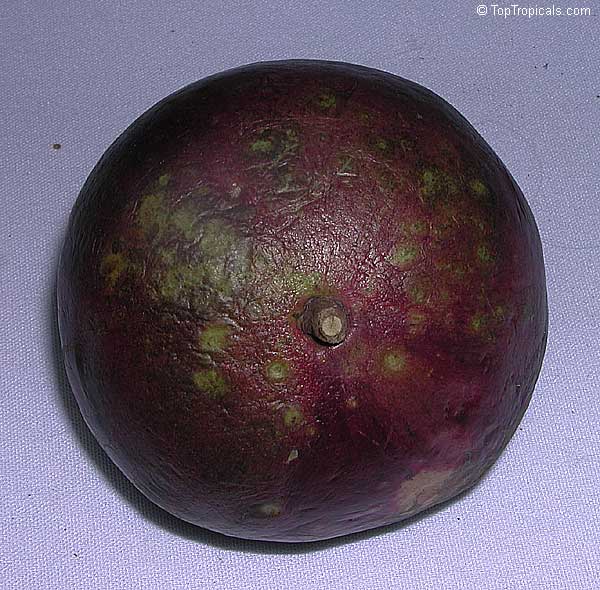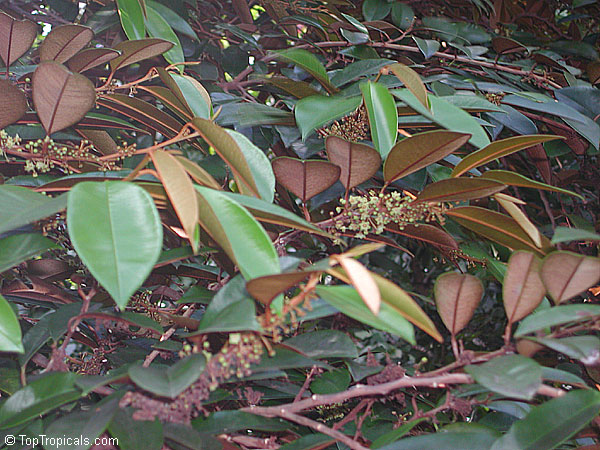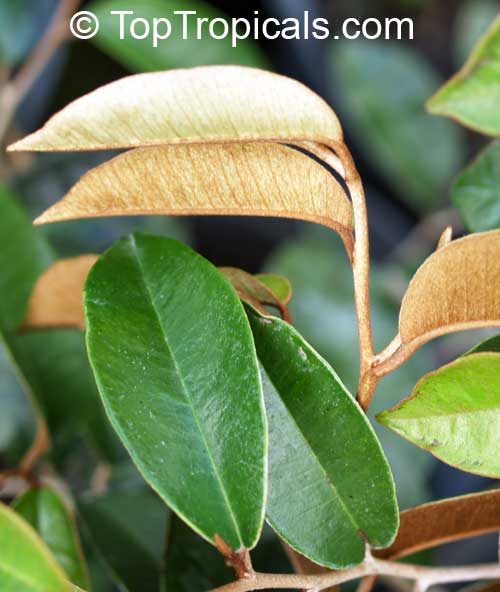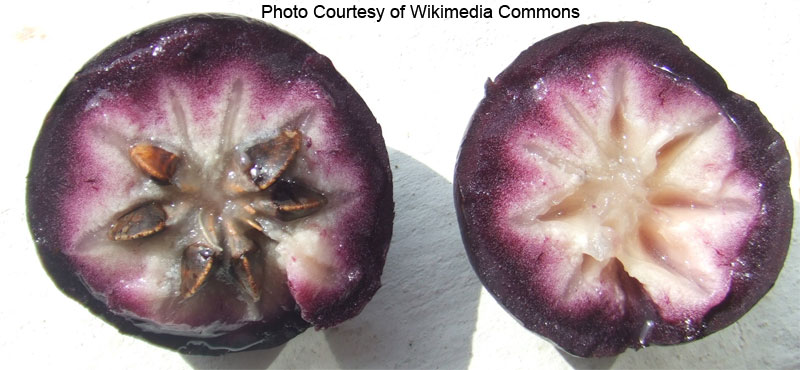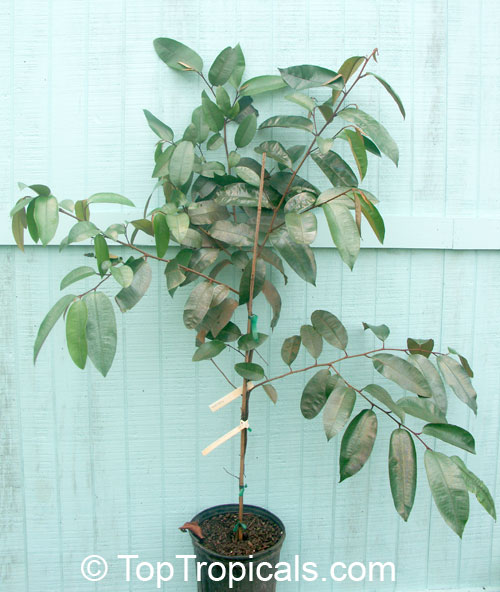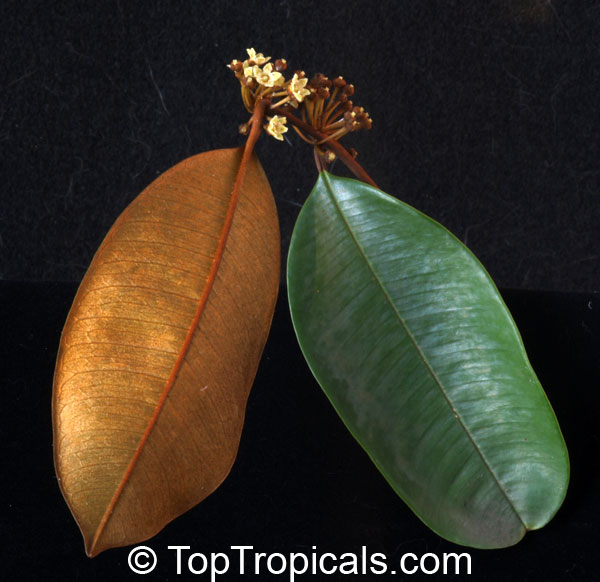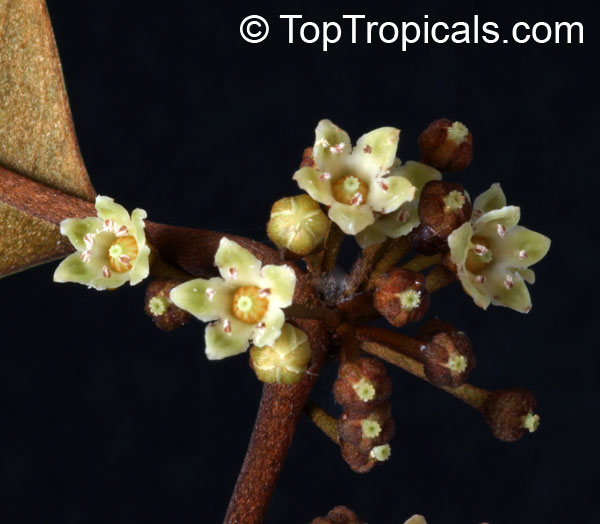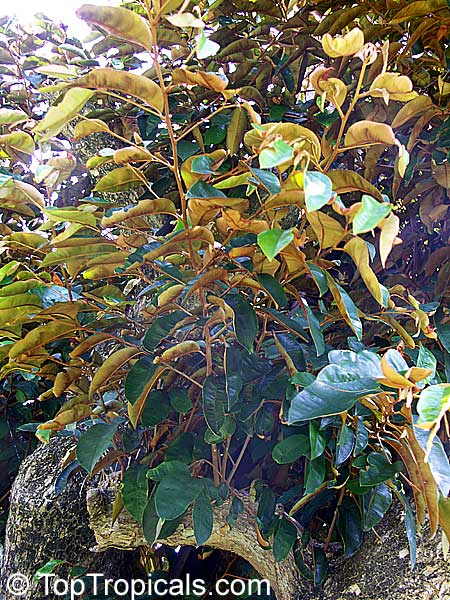Featured plant - a special for your collection
Chrysophyllum cainito - exotic fruit with grape flavor...
Scientific name: Chrysophyllum cainito, Achras caimito
Family: Sapotaceae
Common names: Caimito, Star Apple, Satin Leaf, Golden leaf tree, Abiaba, Pomme du lait, Eestrella, Aguay
Origin: Central America and the West Indies
Varieties: Purple, Green
Season: February-May
This beautiful shade tree has glossy dark green leaves with a silky bronze color underneath. It is one of the most attractive tropical fruit trees for its foliage. The common name of this fruit is derived from the star-like appearance of the core when the fruit is cut in cross section. Caimito is a favorite in the Caribbean and Central America as well as Southeast Asia. The fruit has a mild grape-like flavor, and is best eaten fresh. It is one of the few trees that grows well in highly alkaline soils. it has very few problems and produces quantities of delicious fruit each year for one to enjoy.
Native to tropical America, this fruit tree is now grown commercially in Central and South America as well as tropical Asia and Africa. Occasionally grown commercially in parts of south Florida.
The tree can reach a height of 40 feet in its native areas. The leaves are evergreen, alternate, simple oval, entire, 3-6" long; the underside shines with a golden color when seen from a distance. Leaves are alternate, arranged regularly along branches, in a flat plane. The underside of the leaves is a striking, velvety, somewhat iridescent red, created by dense, soft hair. The twig zig-zags between leaves (like the Annonaceae), and also has soft, red pubescence. Like all Sapotaceae, broken leaves, or cut bark, produces dripping, white latex.
These attractive leaves are deep green above and a silky golden brown beneath and as the wind rustles the foliage this gives a strikingly beautiful effect. The tiny flowers are purplish white and have a sweet fragrant smell. Flowers are produced during the summer through early fall. The tree is hermaphroditic (self-fertile).
The fruit
Trees produce a delicious fruit, and the fruits are born during the early to late spring. The fruit size can be from 2-1/2 to 3 inches in diameter and there are two varieties, one with purple skin and one with green skin. Both have very sweet whitish flesh which is very good and is usually eaten as a fresh fruit. The purple fruit has a denser skin and texture while the greenish brown fruit has a thin skin and a more liquid pulp. The purple-skinned fruit is often green around the calyx, with a star pattern in the pulp. The skin is rich in latex, and both it and the rind are not edible. The flattened seeds are light brown and hard. It bears fruit year around after it reaches about seven years of age. The fruits do not normally drop and, therefore, must be picked and allowed to ripen off the tree.
Cultivation
Trees grow rapidly, often three to four feet or more in a single growing season.
Caimito can grow over a wide range of soils and are one of the few trees that actually grows well in highly alkaline soils, even at pH's up to 7.5.
It is not tolerant of waterlogged conditions and should be grown on well-drained soils. Plant trees in a rich, well-drained soil; once well established, they are quite resistant to most conditions including high winds.
The plant has poor salt tolerance and should be protected by buildings or other more salt tolerant plantings if used close to the ocean or Intracoastal areas.
There are no serious pest problems of trees except birds and other animals that attack maturing fruit.
Sensitivity to cold: the tree may get badly damaged at upper 20's, even mature trees can be frozen to the ground by hard freezes. Temperatures below 28 degrees F will serious injure the mature plant, while young trees exposed to 31 degrees will be killed.
Propagation can be by seed, air layering, or grafting. Seedlings take about six years. Trees can also be air layered but air layering usually takes four to six months to be successful. The 'Haitian' variety, introduced by Bill Whitman, is dark purple, is one of the more common ones seen as grafted or air-layered plants.
Due to recalcitrant nature of the seeds, they have a short viable life, can not be dried well and can not withstand low temperatures.
As long as Caimito is protected from cold winds or freezing temperatures, it has very few problems and produces quantities of delicious fruit each year for one to enjoy.
Use
The fruits are delicious as a fresh dessert fruit; it is sweet and best served chilled. The pulp is usually spooned out as to avoid the bitter tasting rind. The fresh fruit is also often added to salads, drinks, and other dishes.
A traditional food plant in Africa, this little-known fruit has potential to improve nutrition, boost food security, foster rural development and support sustainable landcare. Infusions of the leaves have been used against diabetes and articular rheumatism. The bark is considered a tonic and stimulant, and a bark decoction is used as an antitussive.
Star apple seeds are used in Venezuela as a diuretic and febrifuge. In Cuba, a decoction of the leaves is used as a cancer remedy, while a decoction of the bark is used as an antitussive (cough suppressant).
Other uses of the fruit: as a treatment for diabetes.
Relatives
A closely related species, the Satin-leaf Fruit (Chrysophyllum oliviforme), is grown for its fruit and as an ornamental. The small fruit is oblong in outline and has an objectionable rubberv skin. The purplish pulp, however, has a good flavor and can be used to make an excellent jelly.
Order Caimito:
Purple fruit
Green fruit (rare)
Picture of the actual plant for sale.
Plants are in 3 gal containers,
about 3-4 ft tall, air-layered.
Picture taken November 2008:
